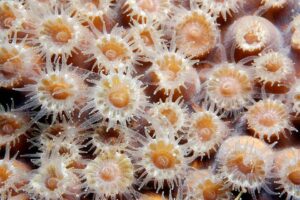For some context, I just did a Night broadcast feeding on my tank to help feed some of the new colonies I got when I noticed this on the cyphastrea. I had this piece for 2-3 weeks and is doing great, no recession, full polyp extension ect. They're not visible during the day and I have noticed this a few times before. It's definitely not dead tissue or skeleton as the colony is fully intact and again, isn't visible during the day. I've always noticed them but never this much, they look like waste but could they be sweepers/feeders? It's not the food as what I'm feeding looks nothing like this. Any ideas?

(The large white spot in the center is a dead coral barnicle)
(The large white spot in the center is a dead coral barnicle)



















